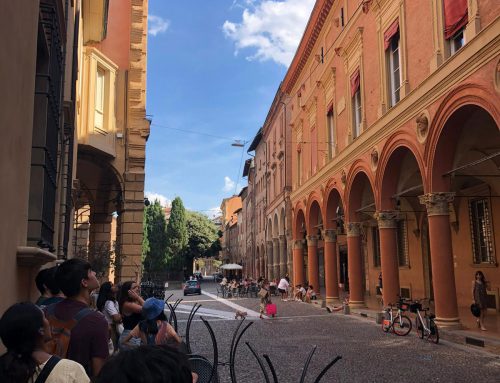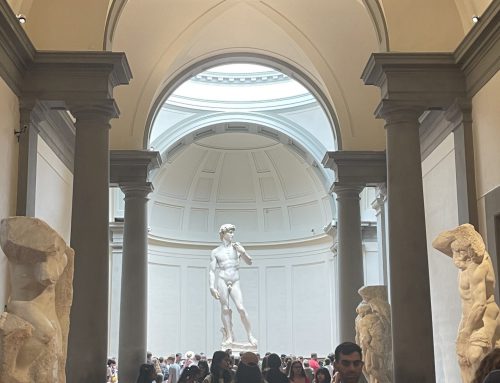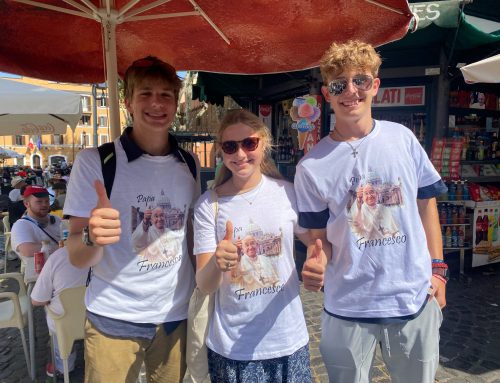July 26th
Ciaowdy!
As Mason and TJ mentioned on yesterday’s blog, today is the penultimate day of our Tuscan experience! Next stop was our tour guide Giovanni’s home city – Cortona. Needless to say, this was going to be good.
After our breakfast at Hotel Park, we boarded a bus to meet Giovanni in Cortona. Since we were ahead of schedule, we had time to frolic in the stunning sunflower fields of Cortona much to Giovanni’s chagrin (the sunflowers were brought to the city in the 1970s, so he deemed the fields cheap and inauthentic). Once the clock struck 10, we made our way to the gates to Cortona’s Archeological Park.
This site has been continuously worked on for over 20 years, holding some of the most significant artifacts of early Italian life. Unlike most ruins and monuments we have seen that dated back to Roman times at the earliest, this dig site was home to Etruscan ruins dating back to the 7th and 8th centuries B.C. Giovanni first led us to a temple site featuring a staircase with lions defending the steps. We then ventured to a family tomb built into a hill; it was very well preserved – even the Etruscan text on the walls was still intact. Even though our time here was short, this stop gave us a glimpse into the origins of the country we have called home for the past two weeks.
Following our tour of the Etruscan archeological site, we boarded our bus and drove to the near-top of the mountain Cortona is situated on. We made a brief stop to see the panoramic view from the peak, stretching from the lake to the seemingly endless mountains and hills of the Tuscan region, before heading to our second official stop of the day: The Basilica of Santa Margherita.
Giovanni wasted no time in informing us that the facade of the Basilica was almost entirely unoriginal, save for the central medallion, and before going in, ensured were thoroughly educated on Italian parking laws (it is important to note that one should never park under the trees, but in the center of the parking lot, no matter how many German tourists yell at you for ruining their pictures).
And even though the thorough cultural education we’d received from our guide Giovanni had taught us more about the grounds of the church itself, nothing prepared us for what awaited us inside.
It was a beautiful church, elaborately painted (the ceiling done by Giovanni’s great-Uncle) with sculptures and marble work scattered throughout, but behind the altar, in the direct center-front of the church, lay the mummified corpse of Santa Margherita herself, in a glass tomb surrounded by silver lattice with a rich blue inlay. Additionally, the face of the mummified Margherita had been reconstructed, standing at what her height would have been when she lived, watching over the congregation of the church from the mini-shrine built for her.
But that wasn’t the only church we attended—after a brief side trip to look at the transition into the baroque period of art at a church that Giovanni was familiar with, we took a trip to yet another church, this one dedicated to St. Francis, a very important and extremely consistent figure in Italian Catholicism, which lay halfway down the mountain of Cortona, and the decision was made to walk down.
Giovanni informed us that the road was modern, but had been designed to look rustic.
Rustic had to be the understatement of the century.
Almost entirely made up of uneven stones jutting from the dirt at a steep incline, the walk down was a game of strategy, of figuring out precisely where to put your foot so that you didn’t slip and roll down the hill. Some of us went down the middle, some the side, closer to the trees and walls, others zigzagging down in order to retain balance, but thankfully, all of us made it down.
The church to Saint Francis was beautiful, too, the ceiling made from wood panels and vaulted in the middle, the frescos on the walls long gone, artistic renderings of biblical events featured in the altars lining the walls instead. To the left of the altar, however, was the true focal point of the church: some relics from the saint himself, brought to Cortona by the closest friend of Francis. There was one of the last tunics he wore, the pillow he slept on as he died, and a book of the gospels rumored to be the one he was often painted with, delicately spread out for the masses to see.
Next door was a gallery that, unfortunately, we didn’t have the time to go into, but that featured maximalistic art of the life of Saint Francis and some events close to the artist, prints of which decorated the church. It drove home the effect of Francis on the people in the city.
From there, we took a look into the parliamentary chamber of the city, the walls painted with lady justice and lady peace, and got a crash course in Cortonese politics before heading to a viewpoint where we got to see Giovanni’s family tomb and another church painted by his great-uncle. It was then we were really hungry, and we split up to get lunch and souvenirs, some of us going to a charming sandwich shop where we had, honestly, the best panino of the trip (fresh arugula and tomato, prosciutto, and mozzarella drizzled in olive oil and pressed in a pan, all of it melting in your mouth the minute you took a bite).
It gave us just enough energy to explore the museum of Cortona, inside of an old Medici-controlled building, that detailed Etruscan and Roman relics and culture, Egyptian and Greek artifacts, and popular Cortonese artists (particularly Severini, who specialized in abstract paintings and drawings), and a 500th anniversary exhibit for Luca Signorelli, a massively famous renaissance painter, the teacher of Michelangelo, and possibly the most famous Cortonese artist in history. We weren’t allowed to take pictures of his work, but it goes without saying that it was rich and elaborate, the use of deep and brighter colors alike meaningful, and it was the most animated we’d seen Giovanni in the days we’d spent together.
From there, we had some do the best gelato of the trip (with which the food tourism enthusiasts were beyond delighted) at Snoopy Gelato. It’s hard to say what the ‘best’ flavor was, as all of it was beyond delicious, rich, and true to the flavor it was meant to be (especially the tiramisu, which tasted exactly like tiramisu, right down to the whipped cream). Evan claims “Smurf” was the best flavor – I didn’t know those blue people could taste like anything, but I won’t judge. It goes without saying that this was the favorite stop of many, as the gentle breeze sweeping through the square with a slightly clouded sun warming our faces coupled with the icy smooth gelato felt like paradise.
Gelato in hand, we began our march through the gardens of Cortona with Giovanni leading the troops. The walk was awe inspiring – just off the cliffs of the trail, one could see cities and farms tens of kilometers away. However, walking a 5K wasn’t on many of our bucket lists, especially after eating our frozen treats. We arrived at a mansion with a massive butterfly garden – Dustin theorized that they even had frizzante (bubbling) water on tap. What comes up must come back down, so we began our trek down the hills of the garden road.
As we boarded the bus to leave Cortona, we had to make a tearful goodbye to the man who had made our past week in Tuscany so special – Giovanni. As a parting gift, we gave our bellissimo tour guide a tumbler with the A&M logo on it, to which he remarked: “This will be my bank cup – it says ATM.” Even though he urged us to forget him, Giovanni’s thunderous presence made an ineffable presence on each and every one of us on the trip.
Back at the hotel, we ate our 3 course dinner and began to wind down. We began to splinter off: one group enjoyed the Castiglion Fiorentino community park once more; one group danced away the night while watching Barbie: Princess Charm School; one group continued the balcony party tradition; and for those of us who were a little too worn out, we crashed early in our rooms. As the eventful day came to a final conclusion, our attention turned to the last full day in Tuscany as we are set visit the majestic city of Florence one final time.
Kyle Oubre ‘27 and Gabrielle Torres-Coley ‘27
Student Leader John Lehan’s words of wisdom for the day: “Great minds think alike, but fools seldom differ.”










